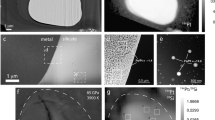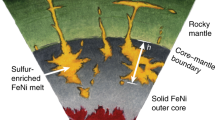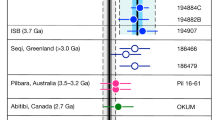Abstract
As the Earth's metallic core segregated from the silicate mantle, some of the moderately siderophile (‘iron-loving’) elements such as vanadium and chromium1,2 are thought to have entered the metal phase, thus causing the observed depletions of these elements in the silicate part of the Earth. In contrast, refractory ‘lithophile’ elements such as calcium, scandium and the rare-earth elements are known to be present in the same proportions in the silicate portion of the Earth as in the chondritic meteorites—thought to represent primitive planetary material1,3. Hence these lithophile elements apparently did not enter the core. Niobium has always been considered to be lithophile and refractory yet it has been observed to be depleted relative to other elements of the same type in the crust and upper mantle4,5. This observation has been used to infer the existence of hidden niobium-rich reservoirs in the Earth's deep mantle5. Here we show, however, that niobium and vanadium partition in virtually identical fashion between liquid metal and liquid silicate at high pressure. Thus, if a significant fraction of the Earth's vanadium entered the core (as is thought), then so has a similar fraction of its niobium, and no hidden reservoir need be sought in the Earth's deep mantle.
This is a preview of subscription content, access via your institution
Access options
Subscribe to this journal
Receive 51 print issues and online access
$199.00 per year
only $3.90 per issue
Buy this article
- Purchase on Springer Link
- Instant access to full article PDF
Prices may be subject to local taxes which are calculated during checkout


Similar content being viewed by others
References
McDonough, W. F & Sun, S .-s. The composition of the Earth. Chem. Geol. 120, 223–253 (1995).
Allègre, C. J., Poirier, J.-P., Hummler, E. & Hofmann, A. W. The chemical composition of the Earth. Earth Planet. Sci. Lett. 134, 515–526 (1995).
Newsom, H. E. in Global Earth Physics (ed. Ahrens., T. J.) 159–189 (American Geophysical Union Reference Shelf 1, Washington DC, 1995).
Hofmann, A. W. Chemical differentiation of the Earth: the relationship between mantle, continental crust and oceanic crust. Earth Planet. Sci. Lett. 90, 297–314 (1988).
Rudnick, R. L., Barth, M., Horn, I. & McDonough, W. F. Rutile-bearing refractory eclogites: missing link between continents and depleted mantle. Science 287, 278–281 (2000).
Drake, M. J., Newsom, H. E. & Capobianco, C. J. V, Cr and Mn in the Earth, Moon, EPB and SPB and the origin of the Moon: Experimental studies. Geochim. Cosmochim. Acta 53, 2101–2111 (1989).
Wasson, J. T. Meteorites: Their Record of Early Solar-system History (Freeman & Co., New York, 1995).
Hofmann, A. W. Mantle geochemistry: the message from oceanic volcanism. Nature 385, 219–228 (1997).
Hofmann, A. W & Jochum, K. P. Source characteristics derived from very incompatible trace elements in Mauna Loa and Mauna Kea basalts, Hawaii Scientific Drilling Project. J. Geophys. Res. 101, 11831–11839 (1996).
Robie, R. A., Hemingway, B. S. & Fisher, J. R. Thermodynamic properties of minerals and related substances at 298.15K and 1 bar (105 Pascals) pressure and at higher temperatures. US Geol. Surv. Bull. 1452 (1978).
Li, J. & Agee, C. B. Geochemistry of mantle-core differentiation at high pressure. Nature 381, 686–689 (1996).
Righter, K., Drake, M. J. & Yaxley, G. Prediction of siderophile element metal-silicate partition coefficients to 20 GPa and 2800 degrees C: The effects of pressure, temperature, oxygen fugacity, and silicate and metallic melt compositions. Phys. Earth Planet. Int. 100, 115–134 (1997).
Righter, K. & Drake, M. J. Effect of water on metal-silicate partitioning of siderophile elements: a high pressure and temperature terrestrial magma ocean and core formation. Earth Planet. Sci. Lett. 171, 383–399 (1999).
Thibault, Y. & Walter, M. J. The influence of pressure and temperature on the metal-silicate partition-coefficients of nickel and cobalt in a model-c1 chondrite and implications for metal segregation in a deep magma ocean. Geochim. Cosmochim. Acta 59, 991–1002 (1995).
Kilburn, M. R. & Wood, B. J. Metal-silicate partitioning and the incompatibility of S and Si during core formation. Earth Planet. Sci. Lett. 152, 139–148 (1997).
Kilburn, M. R. Geochemical Constraints on the Formation of the Earth's Core. Thesis, Univ. Bristol (1999).
Gessmann, C. K., Wood, B. J., Rubie, D. C. & Kilburn, M. R. Solubility of silicon in liquid metal at high pressure: implications for the composition of the Earth's core. Earth Planet. Sci. Lett. (in the press).
Rudnick, R. L. Making continental crust. Nature 378, 571–578 (1995).
Wood, B. J. Phase transformations and partitioning relations in peridotite under lower mantle conditions. Earth Planet. Sci. Lett. 174, 341–354 (2000).
Acknowledgements
This work was supported by the NERC. Experiments at Bayreuth were performed with assistance from the EU Large Scale Facility programme. B.J.W. acknowledges a Max Planck research award.
Author information
Authors and Affiliations
Corresponding author
Rights and permissions
About this article
Cite this article
Wade, J., Wood, B. The Earth's ‘missing’ niobium may be in the core. Nature 409, 75–78 (2001). https://doi.org/10.1038/35051064
Received:
Accepted:
Issue Date:
DOI: https://doi.org/10.1038/35051064
This article is cited by
-
Sub-arc mantle enrichment in the Sunda rear-arc inferred from HFSE systematics in high-K lavas from Java
Contributions to Mineralogy and Petrology (2022)
-
Pan-African rare metals bearing pegmatites in Wadi Ghadir, South Eastern desert, Egypt: the geochemical evolution and implications for mineralization
SN Applied Sciences (2021)
-
Trace element fractionation between biotite, allanite, and granitic melt
Contributions to Mineralogy and Petrology (2021)
-
Nb/Ta systematics in arc magma differentiation and the role of arclogites in continent formation
Nature Communications (2019)
-
Implications of the melting depth and temperature of the Atlantic mid-ocean ridge basalts
Acta Oceanologica Sinica (2019)
Comments
By submitting a comment you agree to abide by our Terms and Community Guidelines. If you find something abusive or that does not comply with our terms or guidelines please flag it as inappropriate.



